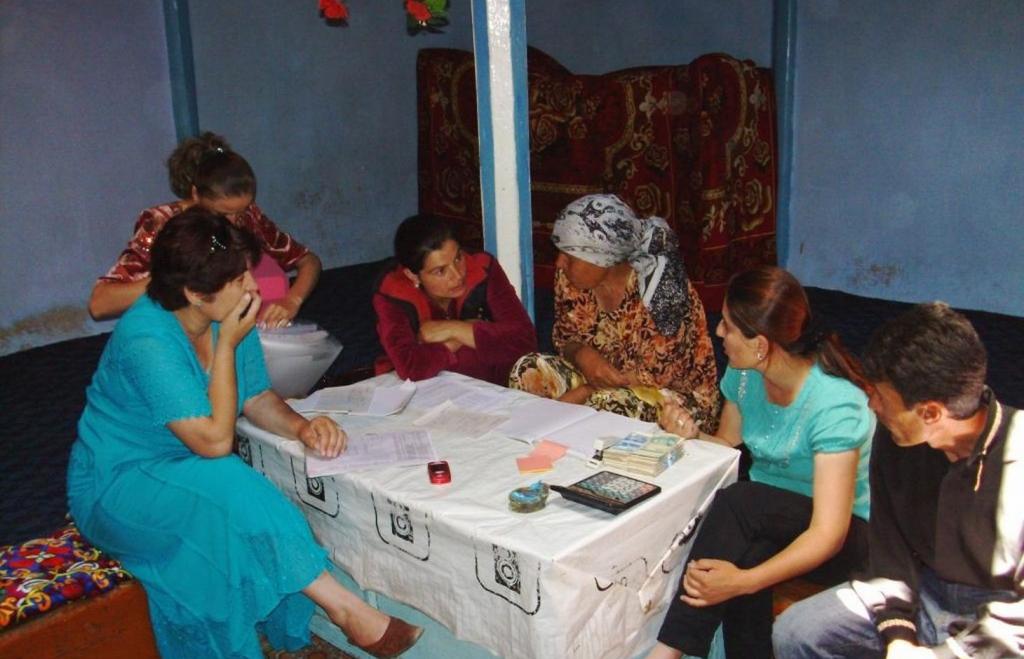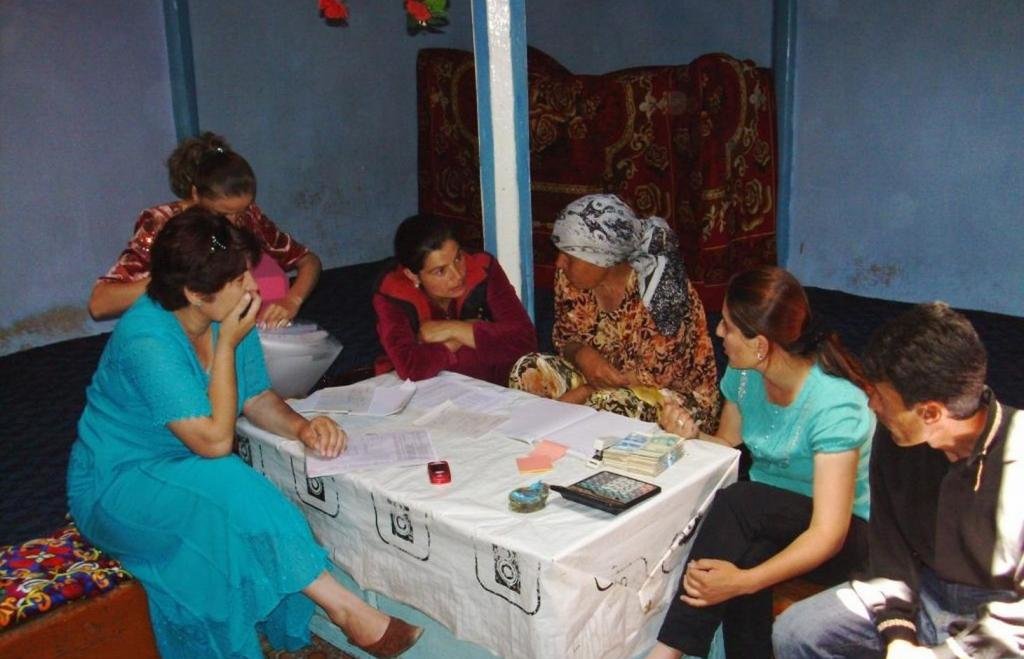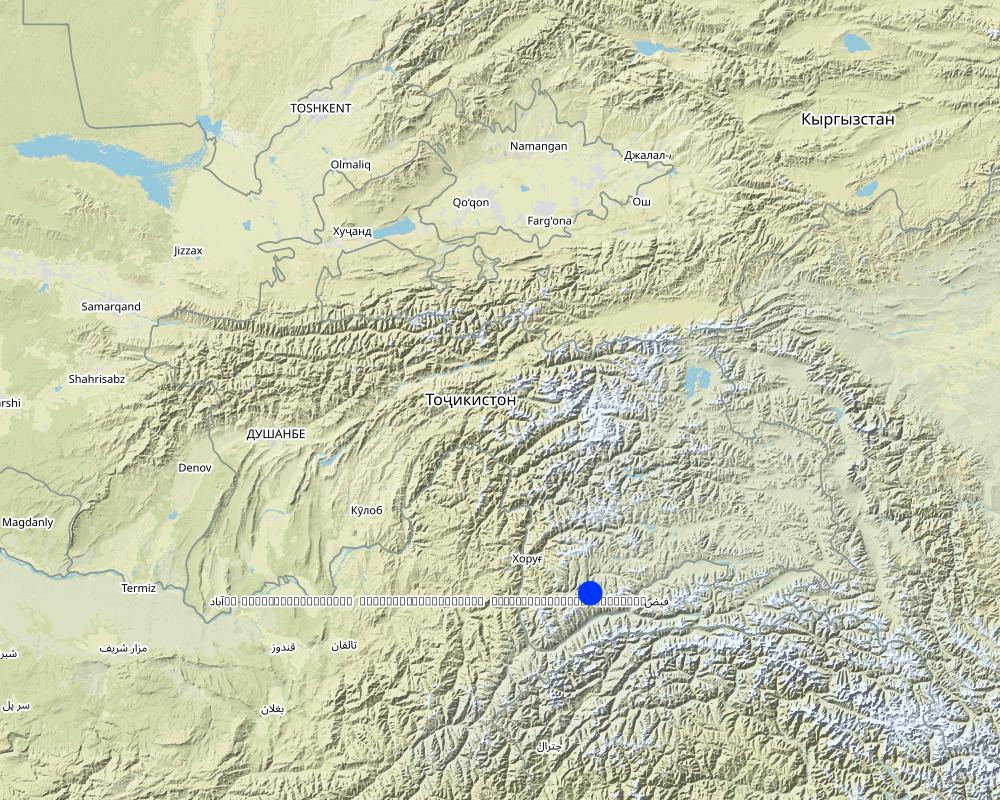Access to thermal insulation through micro loans [ຕາຈິກິສະຕານ]
- ການສ້າງ:
- ປັບປູງ:
- ຜູ້ສັງລວມຂໍ້ມູນ: Roziya Kirgizbekova
- ບັນນາທິການ: –
- ຜູ້ທົບທວນຄືນ: David Streiff, Alexandra Gavilano, Joana Eichenberger
Tajikistan - Central Asian Countries Initiative for Land Management (CACILM/ИСЦАУЗР)
approaches_2575 - ຕາຈິກິສະຕານ
ເບິ່ງພາກສ່ວນ
ຂະຫຍາຍທັງໝົດ ຍຸບທັງໝົດ1. ຂໍ້ມູນທົ່ວໄປ
1.2 ລາຍລະອຽດ ການຕິດຕໍ່ ຂອງບຸກຄົນທີ່ຊັບພະຍາກອນ ແລະ ສະຖາບັນ ການມີສ່ວນຮ່ວມ ໃນການປະເມີນຜົນ ແລະ ເອກະສານ ຂອງວິທີທາງ
ຊື່ຂອງໂຄງການ ທີ່ອໍານວຍຄວາມສະດວກ ໃນການສ້າງເອກກະສານ ຫຼື ປະເມີນດ້ານແນວທາງ (ຖ້າກ່ຽວຂ້ອງ)
Pilot Program for Climate Resilience, Tajikistan (WB / PPCR)ຊື່ຂອງ ສະຖາບັນການຈັດຕັ້ງ ທີ່ອໍານວຍຄວາມສະດວກ ໃນການສ້າງເອກກະສານ ຫຼື ປະເມີນແນວທາງ (ຖ້າກ່ຽວຂ້ອງ)
Central Asian Countries Initiative for Sustainable Land Management - Multicountry Capacity Building (CACILM - MCB) - ກີກັດຕັນ1.3 ເງື່ອນໄຂ ຂອງການນໍາໃຊ້ເອກກະສານຂໍ້ມູນ ຂອງ WOCAT
ເມື່ອໃດທີ່ໄດ້ສັງລວມຂໍ້ມູນ (ຢູ່ພາກສະໜາມ)?
2010
ຜູ້ສັງລວມ ແລະ ບັນດາຜູ້ຕອບແບບສອບຖາມ ຍອມຮັບໃນເງື່ອນໄຂ ການນໍາໃຊ້ຂໍ້ມູນເອກະສານ ທີ່ສ້າງຂື້ນ ໂດຍຜ່ານ ອົງການ WOCAT:
ແມ່ນ
1.4 ເອກະສານອ້າງອີງ (ຫຼາຍ) ກັບແບບສອບຖາມ (ຫຼາຍ) ເຕັກໂນໂລຢີ ຂອງດ້ານການຄຸ້ມຄອງ ດິນແບບຍືນຍົງ
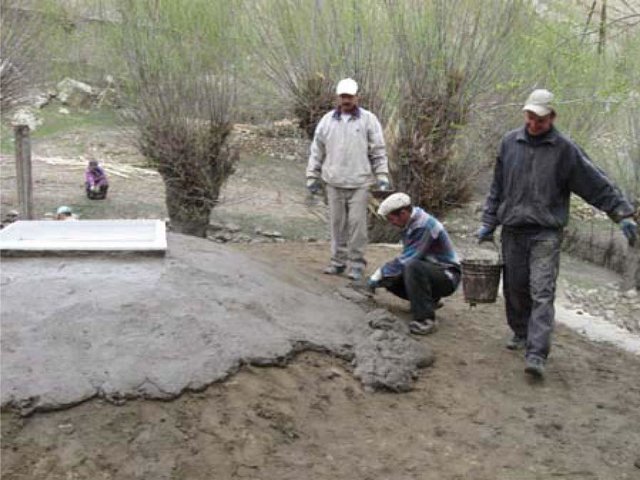
Reduced pressure on forest resources by improved thermal … [ຕາຈິກິສະຕານ]
Thermal insulation of private houses with energy efficient products to reduce the fuel-wood demand and pressures on the natural environment.
- ຜູ້ສັງລວມຂໍ້ມູນ: Roziya Kirgizbekova
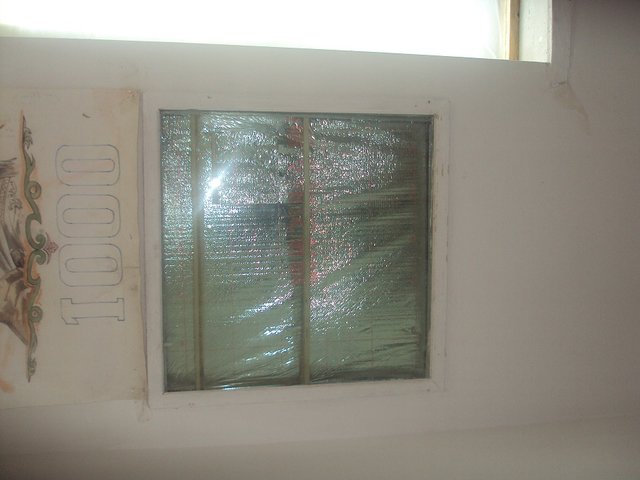
Thermo insulation of walls with use of foil … [ຕາຈິກິສະຕານ]
This technology is designed for the high altitude mountains areas, where biomass and growing trees are limited, first because of the harsh climatic conditions and secondly because of the limited arable lands for growing biomass and forests. Thermo insulation is applied in order to keep warmth inside and save using …
- ຜູ້ສັງລວມຂໍ້ມູນ: Askarsho Zevarshoev
2. ພັນລະນາ ແນວທາງການຄຸ້ມຄອງນໍາໃຊ້ດິນແບບຍືນຍົງ
2.1 ການອະທິບາຍ ໂດຍຫຍໍ້ ຂອງວິທີທາງ
Provision of small scale loans for private households to ensure access to thermal insulation (in the frame of CACILM).
2.2 ການອະທິບາຍ ລາຍລະອຽດ ຂອງວິທີທາງ
ການອະທິບາຍ ລາຍລະອຽດ ຂອງວິທີທາງ:
Aims / objectives: In GBAO as in most parts of Tajikistan, natural resources such as firewood from riparian forests and teresken shrubs, remain the main source of fuel for heating and cooking. Due to poor insulation of local houses, and inefficient cooking stoves, much fuel is burned. The aim is to ensure access to energy efficient technologies through the provision of a micro loan 'Warm comfort' is one of the ways to improve house thermal insulation, reduce fire wood consumption, improve the living standards of residents and reduce pressure on the environment.
Methods: On the basis of financial and technical documentation prepared by field officers and clients MLO Madina made the decision to allocate up to US$500, (2.5% interest rate to be reimbursed within 12 months) to the project. The thermal insulation loan is given in kind and not in cash. The client receives all necessary materials and services for the value it has to reimburse in accordance with the micro loan contract and individual repayment schedule.
Stages of implementation: The process of a micro loan for thermal insulation consists of the following steps: 1) Meeting with the rural population and interviews; 2) information event on energy efficient products and micro loan; 3) Financial analysis to explain micro loans, procedures, household income and expenses analysis; 4) Technical analysis of potential houses to specify types of material needed, type of work, prepare outline of the house; 5) Decision by the MLO Committee to allocate loan; 6) Micro loan contract and work plan; 7) Preparation of thermal insulation works; 8) Implementation of thermal insulation works; 9) Reimbursement of micro loan
Role of stakeholders: The role of each participating stakeholder is indispensable to ensure a smooth flow for the whole process. The funding organisation assists the micro loan organisation with increasing its portfolio and provide loans for thermal insulation. The micro loan organisation develops the micro loan product for thermal insulation, it is responsible for monitoring and it is also part of the committee, which decides to allocate loans. Micro loan field officers in the villages provide financial information on households, which serves as basis for the committee to make the decision. They also regularly monitor the loan reimbursement. Agreement is established with suppliers of quality doors and windows, as well as suppliers of insulation materials such as cement, reflective foil, etc. to have a stable supply of required products. Qualified construction workers trained on thermal insulation install quality doors and windows, improve insulation of existing doors, windows, floors and ceilings. Recipients of the micro loan must show a willingness and an ability to repay the loan.
Other important information: Apart from thermal insulation measures, the micro loan is also available for other energy efficiency products such as: ram pumps, swimming pumps, rain water catchment systems, drip irrigation systems, winter heating and cooking stoves, summer cooking stoves.
2.3 ຮູບພາບຂອງແນວທາງ
2.5 ປະເທດ / ເຂດ / ສະຖານທີ່ບ່ອນທີ່ແນວທາງໄດ້ຖືກນໍາໃຊ້
ປະເທດ:
ຕາຈິກິສະຕານ
ພາກພື້ນ / ລັດ / ແຂວງ:
Tajikistan/Gorno-Badakhshan Autonomous oblast
ຂໍ້ມູນເພີ່ມເຕີມຂອງສະຖານທີ່:
Roshtkala
Map
×2.6 ວັນທີເລີ່ມຕົ້ນ ແລະ ສິ້ນສຸດ ການຈັດຕັ້ງປະຕີບັດ ວິທີທາງ
ສະແດງປີຂອງການເລີ່ມຕົ້ນ:
2009
ຄວາມຄິດເຫັນ:
This approach is implemented in Shugnan, Murgab rayons, and also in Ishkashim
2.7 ປະເພດຂອງແນວທາງ
- ພາຍໃຕ້ໂຄງການ / ແຜນງານ
2.8 ເປົ້າໝາຍ / ຈຸດປະສົງຫຼັກ ຂອງການຈັດຕັ້ງປະຕິບັດ ວິທີທາງ
The Approach focused mainly on other activities than SLM (Micro loan, thermal insulation)
The aim is to ensure easier access to micro loans in order to make it more affordable for the local households to improve their house thermal insulation, and thus reduce fire wood consumption, mitigate health risks, improve general well being and in the longer term, reduce pressure on the environment.
The SLM Approach addressed the following problems: Use of large amounts of firewood/teresken, thus depleting natural resources, to provide heat due to poor house insulation. Lack of sufficient finances to improve house insulation.
2.9 ເງື່ອນໄຂອໍານວຍ ຫຼື ຂັດຂວາງການປະຕິບັດຂອງເຕັກໂນໂລຢີ / ເຕັກໂນໂລຢີການນໍາໃຊ້ຕາມແນວທາງ
ມີຄວາມສາມາດ / ເຂັ້າເຖິງຊັບພະຍາກອນດ້ານການເງິນ ແລະ ການບໍລິການ
- ເຊື່ອງຊ້ອນ
Households do not have enough financial resources available to buy afford thermal insulation for their houses.
Treatment through the SLM Approach: Offer micro loans with a low interest rate to be repaid within 12 months
ກ່ຽວກັບກົດໝາຍ (ສິດນໍາໃຊ້ດິນ, ສິດນໍາໃຊ້ນໍ້າ)
- ອໍານວຍ
- ເຊື່ອງຊ້ອນ
ຄວາມຮູ້ກ່ຽວກັບການຄຸ້ມຄອງ ທີ່ດິນແບບຍືນຍົງ, ການເຂົ້າເຖິງການສະໜັບສະໜູນ ທາງດ້ານວິຊາການ
- ເຊື່ອງຊ້ອນ
Lack of technical knowledge on thermal insulation techniques
Treatment through the SLM Approach: Technical support, recommendations and conducting thermal insulation
ວຽກ, ມີກໍາລັງຄົນ
- ເຊື່ອງຊ້ອນ
Households spend a large amount of time on collecting fuel resources to burn for heating and cooking
Treatment through the SLM Approach: Less workload due to reduced required amount of fuel
ອື່ນໆ
- ເຊື່ອງຊ້ອນ
Lack of knowledge about the correlation between poor insulation and fuel consumption.
Treatment through the SLM Approach: Awareness raising about positive effects of thermal insulation and product promotion
3. ການມີສ່ວນຮ່ວມ ແລະ ບົດບາດຂອງພາກສ່ວນທີ່ກ່ຽວຂ້ອງທີ່ໄດ້ມີສ່ວນຮ່ວມ
3.1 ຜູ້ມີສ່ວນຮ່ວມ ໃນວິທີທາງ ແລະ ພາລະບົດບາດ ຂອງເຂົາເຈົ້າ
- ຜູ້ນໍາໃຊ້ດິນໃນທ້ອງຖິ່ນ / ຊຸມຊົນທ້ອງຖິ່ນ
Households who took out a loan for thermal insulation
Households which cannot afford thermal insulation costs in one go, as it is a big financial burden for them, make use of the micro loan. Especially, female-headed households that have very little income.
- ຜູ້ຊ່ຽວຊານ ການນຄຸ້ມຄອງ ທີ່ດິນແບບຍືນຍົງ / ທີ່ປຶກສາດ້ານກະສິກໍາ
Thermal insulation advisers
- ອົງການຈັດຕັ້ງ ທີ່ບໍ່ຂື້ນກັບລັດຖະບານ
MLO 'Madina'
Approach was developed jointly by local MLO Madina and GIZ Project 'Sustainable Management of Natural Resources in GBAO' in order to suit thermal insulation
- ອົງການຈັດຕັ້ງ ສາກົນ
Deutsche Gesellschaft für Internationale Zusammenarbeit (GIZ) GmbH
- Suppliers of doors, windows and construction materials, workers
3.2 ການມີສ່ວນຮ່ວມຂອງຜູ້ນໍາໃຊ້ທີ່ດິນໃນທ້ອງຖິ່ນ / ຊຸມຊົນທ້ອງຖິ່ນໃນໄລຍະທີ່ແຕກຕ່າງກັນຂອງແນວທາງ
| ການລວບລວມ ເອົາຜູ້ນໍາໃຊ້ດິນ ໃນທ້ອງຖິ່ນ / ຊຸມຊົນທ້ອງຖິ່ນ | ໃຫ້ລະບຸ ຜູ້ໃດທີ່ມີສ່ວນຮ່ວມ ໃນແຕ່ລະກິດຈະກໍາ? | |
|---|---|---|
| ການເລີ່ມຕົ້ນ / ແຮງຈູງໃຈ | ການຮ່ວມມື | Household members take part in public meetings and awareness raising workshops |
| ການວາງແຜນ | ການຮ່ວມມື | Household members jointly with technical and financial specialists prepare a work plan for implementing the insulation works |
| ການປະຕິບັດ | ການບໍ່ປະຕິບັດ | |
| ຕິດຕາມກວດກາ / ການປະເມີນຜົນ | ການຮ່ວມມື | The users and specialists assess the efficiency of the micro loan and its procedures |
| Research | ບໍ່ມີ |
3.4 ການຕັດສິນໃຈກ່ຽວກັບການຄັດເລືອກເຕັກໂນໂລຢີຂອງການຄຸ້ມຄອງທີ່ດິນແບບຍືນຍົງ / ເຕັກໂນໂລຢີ
ລະບຸ ຄົນທີ່ຕັດສິນໃຈ ກ່ຽວກັບການຄັດເລືອກຂອງ ເຕັກໂນໂລຢີ / ເຕັກໂນໂລຢີ ຈະໄດ້ຮັບການປະຕິບັດ:
- ຊຽ່ວຊານ ສະເພາະດ້ານການຄຸ້ມຄອງ ດິນແບບຍືນຍົງຜູ້ດຽວ
ອະທິບາຍ:
Decisions on the method of implementing the SLM Technology were made by by SLM specialists alone (top-down)
4. ການສະໜັບສະໜູນທາງດ້ານວິຊາການ, ການສ້າງຄວາມສາມາດ, ແລະ ການຈັດການຄວາມຮູ້.
4.1 ການສ້າງຄວາມສາມາດ / ການຝຶກອົບຮົມ
ຜູ້ນໍາໃຊ້ທີ່ດິນ ຫຼື ພາກສ່ວນກ່ຽວຂ້ອງອື່ນໆ ໄດ້ຮັບການຝຶກອົບຮົມບໍ່?
ແມ່ນ
ໃຫ້ລະບຸ ຜູ້ໃດທີ່ໄດ້ຮັບການຝຶກອົບຮົມ:
- ຜູ້ນໍາໃຊ້ດິນ
- ພະນັກງານພາກສະໜາມ / ທີ່ປຶກສາ
- Craftsmen
ຮູບແບບຂອງການຝຶກອົບຮົມ:
- ເນື້ອທີ່ສວນທົດລອງ
- ກອງປະຊຸມ
- ຫຼັກສູດ
ໃນຫົວຂໍ້:
Awareness raising among the local population on the reasons for, and the effects of bad insulation of houses. The advantages and disadvantages of thermal insulation. Information on existing funding opportunities for thermal insulation. Training of local craftsmen on thermal insulation technologies, and the production of quality and well-insulated doors and windows.
4.2 ການບໍລິການໃຫ້ຄໍາປຶກສາ
ເຮັດຜູ້ໃຊ້ທີ່ດິນມີການເຂົ້າເຖິງການບໍລິການໃຫ້ຄໍາປຶກສາ?
ບໍ່ແມ່ນ
4.3 ສະຖາບັນການສ້າງຄວາມເຂັ້ມແຂງ (ການພັດທະນາອົງການຈັດຕັ້ງ)
ສະຖາບັນ ໄດ້ຮັບການສ້າງຕັ້ງຂື້ນ ຫຼື ໄດ້ຮັບການສ້າງຄວາມເຂັ້ມແຂງ ໂດຍການຈັດຕັ້ງປະຕິບັດ ວິທີທາງບໍ່?
- ບໍ່ມີ
4.4 ຕິດຕາມກວດກາ ແລະ ປະເມີນຜົນ
ການຈັດຕັ້ງປະຕິບັດ ວິທີທາງ ໄດ້ມີການປະເມີນຜົນ ແລະ ຕິດຕາມບໍ?
ແມ່ນ
ຄວາມຄິດເຫັນ:
no. of land users involved aspects were regular monitored by project staff through measurements; indicators: None
economic / production aspects were ad hoc monitored by project staff through measurements; indicators: None
economic / production aspects were regular monitored by land users through observations; indicators: None
technical aspects were regular monitored by project staff through measurements; indicators: None
technical aspects were regular monitored by land users through observations; indicators: None
management of Approach aspects were None monitored by project staff through measurements; indicators: None
There were few changes in the Approach as a result of monitoring and evaluation: Initially the micro loan was provided in cash directly to the households, but the results of monitoring showed that not the full amount of the loan was used for thermal insulation purposes. Therefore the MLO decided to allocate the loan for thermal insulation in kind; in the form of products and services, which proved to be more efficient.
There were few changes in the Technology as a result of monitoring and evaluation: Following ongoing discussions with craftsman and construction workers a follow-up seminar was conducted, where problems and possible changes were discussed in order to improve the quality of thermal insulation products. E.g. the roof hatch window had an opening, but it was not possible to open it from inside the room. As consequence every subsequent roof hatch window will have a lever connected to a string in order to open the window more easily.
4.5 ການຄົ້ນຄວ້າ
ນີ້້ແມ່ນສ່ວນໜຶ່ງ ການຄົ້ນຄວ້າ ຂອງວິທີທາງບໍ່?
ບໍ່ແມ່ນ
5. ການສະໜັບສະໜູນທາງດ້ານການເງິນ ແລະ ອຸປະກອນຈາກພາຍນອກ
5.1 ງົບປະມານປະຈໍາປີ ສໍາລັບວິທີທາງ ຂອງການຄຸ້ມຄອງ ທີ່ດິນແບບຍືນຍົງ
ຖ້າຫາກບໍ່ຮູ້ຈັດງົບປະມານທີ່ແນ່ນອນ ແມ່ນໃຫ້ປະມານເອົາ:
- 2,000-10,000
ຄໍາເຫັນ (ຕົວຢ່າງ: ແຫຼ່ງຂໍ້ມູນຫຼັກ ຂອງການສະໜອງທຶນ / ຜູ້ໃຫ້ທຶນທີ່ສໍາຄັນ):
Approach costs were met by the following donors: local community / land user(s) (Micro loan borrower pays for insulation materials, construction, installation): 90.0%; private sector (MLO Madina offers technical and financial consultancy free of charge): 1.5%; international (GIZ grant for allocating micro loans ): 3.5%; other (Transportation ): 5.0%
5.2 ການສະໜັບສະໜູນ ທາງດ້ານການເງິນ / ອຸປະກອນ ສະໜອງໃຫ້ແກ່ຜູ້ນໍາທີ່ດິນ
ຜູ້ນໍາໃຊ້ດິນ ໄດ້ຮັບການສະໜັບສະໜູນ ທາງດ້ານ ການເງິນ / ອຸປະກອນ ໃນການຈັດຕັ້ງປະຕິບັດ ເຕັກໂນໂລຢີບໍ?
ບໍ່ແມ່ນ
5.3 ເງິນສົມທົບສໍາລັບການນໍາໃຊ້ສະເພາະປັດໃຈຂາເຂົ້າໃນການຜະລີດກະສິກໍາ (ລວມທັງແຮງງານ)
- ການກໍ່ສ້າງ
| ໃຫ້ລະບຸໄດ້ຮັບການສະໜັບສະໜູນປັດໃຈຂາເຂົ້າຫຍັງແດ່ | ທີ່ຂອບເຂດ | ລະບຸ ການອຸດໜູນ |
|---|---|---|
| doors, windows, insulation materials | repayable loans. | |
ຄວາມຄິດເຫັນ:
The micro loan fully covers the costs for purchasing doors, windows and insulation material as well as the installation. The transportation costs for delivering the products is paid separately in cash by the client.
5.4 ສິນເຊື່ອ
ໄດ້ປ່ອຍສິນເຊື່ອ ສະໜອງໃຫ້ພາຍໃຕ້ ວິທີການສໍາລັບກິດຈະກໍາ ການຄຸ້ມຄອງ ທີ່ດິນແບບຍືນນຍົງບໍ່?
ແມ່ນ
ເງື່ອນໄຂກໍານົດ (ອັດຕາດອກເບ້ຍ, ຈ່າຍຄືນ, ແລະ ອື່ນໆ) :
Interest rate charged: 30.0%; repayment conditions: Repayment should be completed within 12 months, with 1 month grace period allowed. This equates to a 2.5% interest rate per month..
Interest was lower than market rate.
ລະບຸ ຜູ້ທີ່ໄດ້ຮັບສິນເຊື່ອ:
Individual households receive credit to implement house thermal insulation
5.5 ສິ່ງຈູງໃຈ ຫຼື ເຄື່ອງມືອື່ນໆ
ການສົ່ງເສີມ ຈັດຕັ້ງປະຕິບັດ ເຕັກໂນໂລຢີ ໃນການຄຸ້ມຄອງ ດິນແບບຍືນຍົງ ໄດ້ສະໜອງສິ່ງກະຕຸກຊຸກຍູ້ບໍ່?
ບໍ່ແມ່ນ
6. ວິເຄາະຜົນກະທົບ ແລະ ສັງລວມບັນຫາ
6.1 ຜົນກະທົບຂອງແນວທາງ
ການຈັດຕັ້ງປະຕິບັດ ວິທີທາງ ສາມາດຊ່ວຍຜູ້ນໍາໃຊ້ທີ່ດິນ ໃນການຈັດຕັ້ງປະຕິບັດ ແລະ ບໍາລຸງຮັກສາ ເຕັກໂນໂລຢີ ການຄຸ້ມຄອງ ທີ່ດິນແບບຍືນຍົງໄດ້ບໍ?
- ບໍ່
- ມີ, ໜ້ອຍໜຶ່ງ
- ມີ, ພໍສົມຄວນ
- ມີ, ຫຼາຍ
Micro loans were given so people could afford to thermally insulate their houses, which reduces fire wood consumption and thus contributes to the preservation and improvement of natural vegetation.
ການຈັດຕັ້ງປະຕິບັດ ວິທີທາງ ສາມາດສ້າງຄວາມເຂັ້ມແຂງ ທາງສັງຄົມ ແລະ ເສດຖະກິດບໍ່?
- ບໍ່
- ມີ, ໜ້ອຍໜຶ່ງ
- ມີ, ພໍສົມຄວນ
- ມີ, ຫຼາຍ
Households save time and money on fuel, and can use this money for other purposes.
Did other land users / projects adopt the Approach?
- ບໍ່
- ມີ, ໜ້ອຍໜຶ່ງ
- ມີ, ພໍສົມຄວນ
- ມີ, ຫຼາຍ
Following MLO Madina, other MLOs in Tajikistan started to include “Micro loans for thermal insulation” into their portfolio. One is MLO Ishkashim in GBAO, a second one is MLO Haqiq in the Baljuvon District of the Khatlon Region.
Did the Approach lead to improved livelihoods / human well-being?
- ບໍ່
- ມີ, ໜ້ອຍໜຶ່ງ
- ມີ, ພໍສົມຄວນ
- ມີ, ຫຼາຍ
The household living conditions were improved as they now live in warmer and more comfortable houses with reduced health risks
Did the Approach help to alleviate poverty?
- ບໍ່
- ມີ, ໜ້ອຍໜຶ່ງ
- ມີ, ພໍສົມຄວນ
- ມີ, ຫຼາຍ
6.2 ແຮງຈູງໃຈຫຼັກຂອງຜູ້ນໍາໃຊ້ທີ່ດິນໃນການປະຕິບັດການຄຸ້ມຄອງທີ່ດິນແບບຍືນຍົງ
- ການຫຼຸດຜ່ອນພາລະວຽກ
Less time is spent on collecting fire wood
- ຄວາມຮັບຮູ້ ທາງສີ່ງແວດລ້ອມ
Fear to fully destroy the surrounding nature
- well-being and livelihoods improvement
Well-insulated houses allow households to save money and live more comfortably
6.3 ຄວາມຍືນຍົງຂອງກິດຈະກໍາວິທີທາງ
ຜູ້ນໍາໃຊ້ ທີ່ດິນ ສາມາດສືບຕໍ່ ການຈັດຕັ້ງປະຕິບັດ ຜ່ານວິທີທາງໄດ້ບໍ່ (ໂດຍປາດສະຈາກ ການຊ່ວຍເຫຼືອ ຈາກພາກສ່ວນພາຍນອກ)?
- ແມ່ນ
ຖ້າ ໄດ້, ອະທິບາຍເຫດຜົນ:
Sustainability is guaranteed by incentives along the value chain and introduced market mechanisms
6.4 ຈຸດແຂງ / ຂໍ້ດີ ຂອງວິທີທາງ
| ຈຸດແຂງ / ຂໍ້ດີ / ໂອກາດໃນການນໍາໃຊ້ທີ່ດິນ |
|---|
| Improved knowledge on thermal insulation and micro loans |
| Access to thermal insulation |
| Reduced costs for fuel consumption |
| ຈຸດແຂງ / ຈຸດດີ / ໂອກາດ ຈາກທັດສະນະຂອງຜູ້ປ້ອນຂໍ້ມູນ ຫຼື ບຸກຄົນສຳຄັນ |
|---|
| Less harm to the environment |
| There was control of the whole process to ensure efficiency |
| Improved living conditions |
| Financial source with low interest rate |
6.5 ຈຸດອ່ອນ / ຂໍ້ເສຍຂອງແນວທາງ ແລະ ວິທີການແກ້ໄຂໃຫ້ເຂົາເຈົ້າ
| ຈຸດອ່ອນ ຫຼື ຂໍ້ເສຍ ຫຼື ຄວາມສ່ຽງ ໃນມຸມມອງຂອງ ຜູ້ສັງລວມຂໍ້ມູນ ຫຼື ບັນດາຜູ້ຕອບແບບສອບຖາມ | ມີວິທີການແກ້ໄຂຄືແນວໃດ? |
|---|---|
| Some households still cannot afford the loan | Search for donor funding to establish a separate loan for the most poor |
| Whether MLO can sustain the interest rates without support coming from grants | The interests rates are still high, there could be a reduction in interest rate or the further payment holidays. |
| Costs for training and awareness raising | Initial investments as MLO cannot finance these activities |
7. ເອກກະສານອ້າງອີງ ແລະ ຂໍ້ມູນການເຊື່ອມໂຍງ
7.1 ວິທີການ / ແຫຼ່ງຂໍ້ມູນ
- ການໄປຢ້ຽມຢາມພາກສະໜາມ, ການສໍາຫຼວດພາກສະໜາມ
- ການສໍາພາດ ຜູ້ນໍາໃຊ້ທີ່ດິນ
7.3 ການເຊື່ອມຕໍ່ກັບຂໍ້ມູນທີ່ກ່ຽວຂ້ອງທີ່ສາມາດໃຊ້ອອນໄລນ໌
ຫົວຂໍ້ / ພັນລະນາ:
Micro loans for thermal insulation: A product documentation based on the experience of Tajik Gorno Badakhshan, Andre Fabian, Heike Volkmer, Christoph Wiedemann, 2010
URL:
http://www.naturalresources-centralasia.org/assets/files/2010-09-15_product_documentation_thermal_insulation_FINAL_rus.pdf
ຂໍ້ມູນການເຊື່ອມຕໍ່ ແລະ ເນື້ອໃນ
ຂະຫຍາຍທັງໝົດ ຍຸບທັງໝົດການເຊື່ອມຕໍ່

Reduced pressure on forest resources by improved thermal … [ຕາຈິກິສະຕານ]
Thermal insulation of private houses with energy efficient products to reduce the fuel-wood demand and pressures on the natural environment.
- ຜູ້ສັງລວມຂໍ້ມູນ: Roziya Kirgizbekova

Thermo insulation of walls with use of foil … [ຕາຈິກິສະຕານ]
This technology is designed for the high altitude mountains areas, where biomass and growing trees are limited, first because of the harsh climatic conditions and secondly because of the limited arable lands for growing biomass and forests. Thermo insulation is applied in order to keep warmth inside and save using …
- ຜູ້ສັງລວມຂໍ້ມູນ: Askarsho Zevarshoev
ເນື້ອໃນ
ບໍ່ມີເນື້ອໃນ


